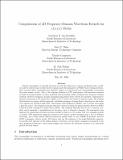| dc.contributor.author | Nihei, Kurt T. | |
| dc.contributor.author | Ajo-Franklin, Jonathan B. | |
| dc.contributor.author | Campman, Xander | |
| dc.contributor.author | Toksoz, M. Nafi | |
| dc.contributor.other | Massachusetts Institute of Technology. Earth Resources Laboratory | en_US |
| dc.date.accessioned | 2012-01-05T20:12:49Z | |
| dc.date.available | 2012-01-05T20:12:49Z | |
| dc.date.issued | 2006-05-28 | |
| dc.identifier.uri | http://hdl.handle.net/1721.1/67923 | |
| dc.description.abstract | Seismic tomography, as typically practiced on both the exploration, crustal, and global scales, considers only the arrival times of selected sets of phases and relies primarily on WKBJ theory during inversion. Since the mid 1980’s, researchers have explored, largely on a theoretical level, the possibility of inverting the entire seismic record. Due to the ongoing advances in CPU performance, full waveform inversion is finally becoming feasible on select problems with promising results emerging from frequency-domain methods. However, frequency-domain techniques using sparse direct solvers are currently constrained by memory limitations in 3D where they exhibit a O(n4) worst-case bound on memory usage. We sidestep this limitation by using a hybrid approach, calculating frequency domain Green’s functions for the scalar wave equation by driving a high-order, time-domain, finite-difference (FDTD) code to steady state using a periodic source. The frequency-domain response is extracted using the phase sensitive detection (PSD) method recently developed by Nihei and Li (2006). The resulting algorithm has an O(n3) memory footprint and is amenable to parallelization in the space, shot, or frequency domains. We demonstrate this approach by generating waveform inversion kernels for fully c(x,y,z) models. Our test examples include a realistic VSP experiment using the geometry and velocity models obtained from a site in Western Wyoming, and a deep crustal reflection/refraction profile based on the LARSE II geometry and the SCEC community velocity model. We believe that our 3D solutions to the scalar Helmholtz equation, for models with upwards of 100 million degrees of freedom, are the largest examples documented in the open geophysical literature. Such results suggest that iterative 3D waveform inversion is an achievable goal in the near future. | en_US |
| dc.description.sponsorship | Shell GameChanger | en_US |
| dc.description.sponsorship | Massachusetts Institute of Technology. Earth Resources Laboratory | en_US |
| dc.publisher | Massachusetts Institute of Technology. Earth Resources Laboratory | en_US |
| dc.relation.ispartofseries | Earth Resources Laboratory Industry Consortia Annual Report;2006-11 | |
| dc.title | Computation of 3D Frequency-Domain Waveform Kernals for c(x,y,z) Media | en_US |
| dc.type | Technical Report | en_US |
| dc.contributor.mitauthor | Ajo-Franklin, Jonathan B. | |
| dc.contributor.mitauthor | Campman, Xander | |
| dc.contributor.mitauthor | Toksoz, M. Nafi | |
| dspace.orderedauthors | Ajo-Franklin, Jonathan B.; Nihei, Kurt T.; Campman, Xander; Toksoz, M. Nafi | en_US |

